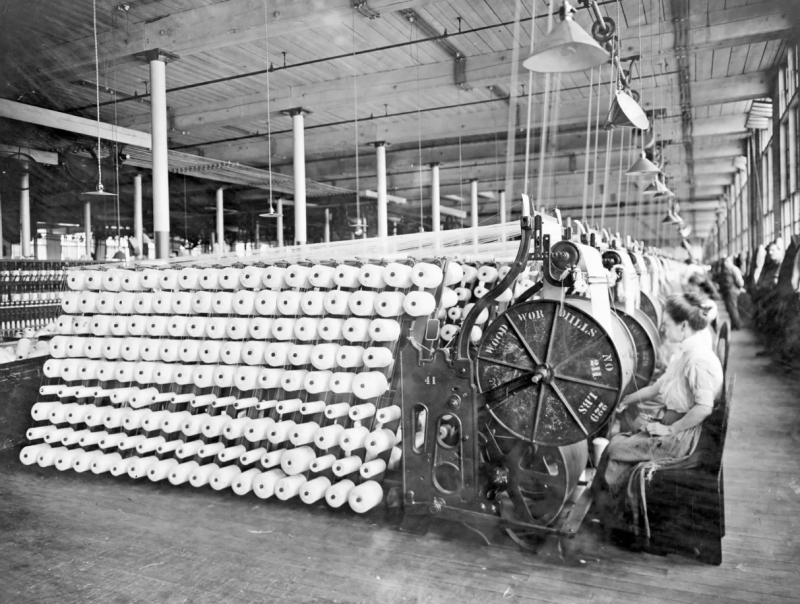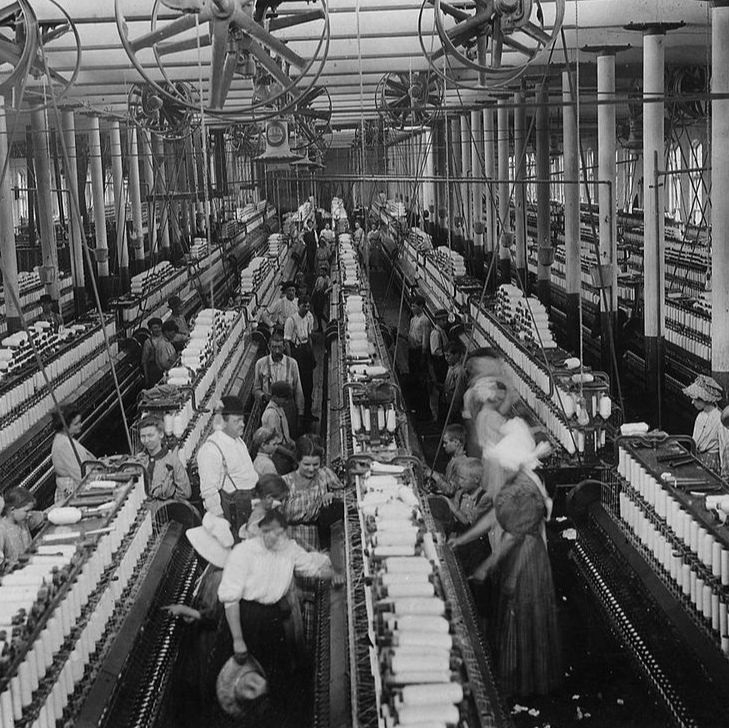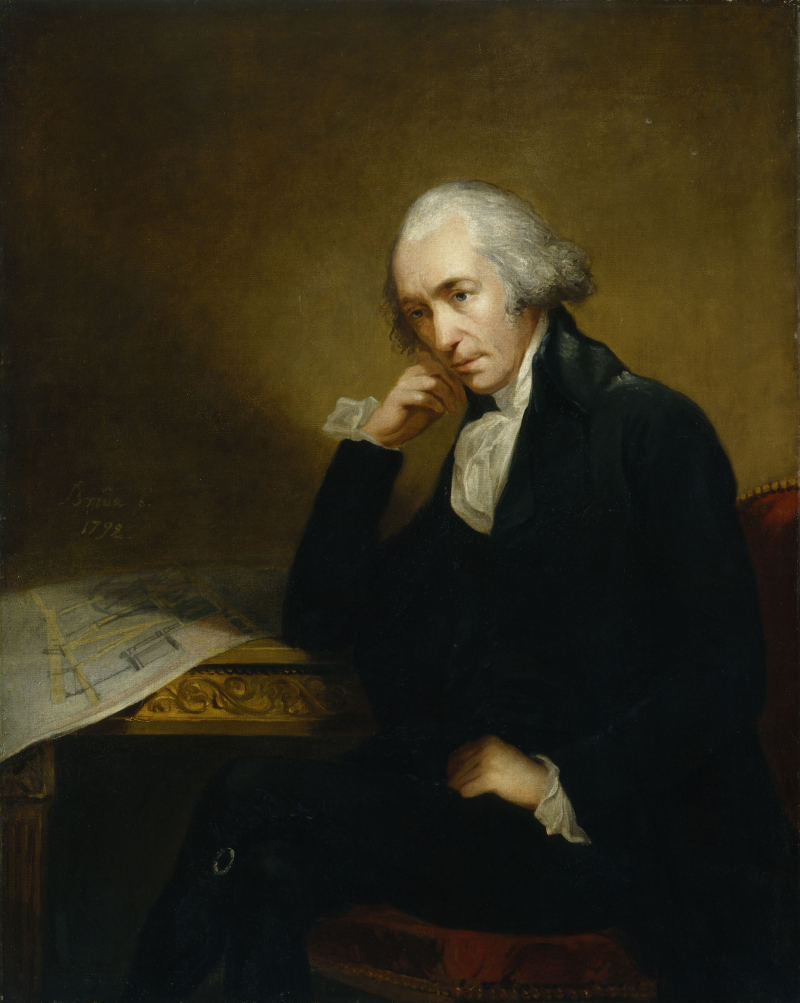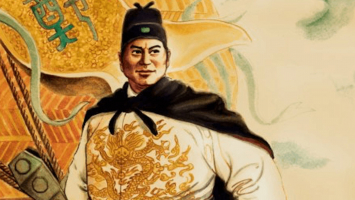Top 8 Interesting Facts About The Industrial Revolution
The Industrial Revolution was the transition to new manufacturing processes in the United Kingdom, continental Europe, and the United States from around 1760 ... read more...to between 1820 and 1840. This transition comprised the transition from manual production methods to machines, new chemical manufacturing, and iron production processes, increased use of steam and water power, machine tool development, and the establishment of the mechanized factory system. And now let's have a look at the 8 interesting facts about the Industrial Revolution.
-
One of the interesting facts about the Industrial Revolution is that it began first in Britain. The Industrial Revolution began in Britain in the second part of the 18th century, with a number of technical innovations, including the discovery of the steam engine, as well as new methods of producing iron and steel that made them cheaper and easier to create.
One of the primary reasons the Industrial Revolution began in Great Britain was that many of the key technologies and ideas that propelled the revolution were made there. The spinning jenny, water frame, and spinning mule were among the first innovations in the cotton business. With his steam engine, James Watt created what was maybe the most important technology of the day. In 1776, he improved on Thomas Newcomen's 1712 Newcomen steam engine with the Watt steam engine. This engine was more efficient and powerful, and it was quickly expanded to power factory machines, as well as steamships at sea and locomotives on tracks. Other industries quickly profited from industrialization. Other innovations were Henry Bessemer's revolutionary steel-making methods, mass-production, assembly lines, electrical grid systems, and other modern machinery in steam-powered companies.
Another important reason why the Industrial Revolution began in Great Britain was the abundance of land, labor, and capital. Coal was required in large amounts to fuel steam engines and furnaces throughout the Industrial Revolution. Iron ore was required for machines, structures, and bridges. Both were abundant in England, as were rivers for inland transportation. Furthermore, the growing population assisted in the production of labor for the industries and mines that were critical to the Industrial Revolution. The increased population generated a market for items to be sold, allowing factory owners to benefit from the sale of their goods. Furthermore, the well-developed banking system in Great Britain enabled loans to be made to industries in order to help them succeed. England's political structure fostered trade and entrepreneurship. A simple legal structure allowed for the founding of joint-stock firms, the enforcement of property rights, and the respect of patents for inventions.
The final reason Britain was the first country to industrialize was due to its massive colonial empire. When the Industrial Revolution began, Britain was in the midst of the Age of Imperialism, in which European nations explored and ruled enormous swaths of land throughout the world. This was significant because it provided Britain with access to vast amounts of natural resources. In addition, the colonies granted Britain exclusive trading rights over hundreds of millions of people. As a result, Britain now has a large market in which to sell its goods.

englishfinecottons.co.uk 
medium.com -
The Industrial Revolution, the biggest event in human history, was the transition to new manufacturing methods in the United Kingdom, continental Europe, and the United States from around 1760 until between 1820 and 1840. This transition comprised the transfer from manual to machine production methods, new chemical manufacturing and iron production processes, increased use of steam and water power, the creation of machine tools, and the rise of the mechanized factory system. Output rose dramatically, resulting in an unprecedented increase in population and pace of population growth.
Textiles were the Industrial Revolution's major industry in terms of employment, output value, and capital invested. The textile sector was also the first to employ contemporary manufacturing techniques.
The Industrial Revolution began in the United Kingdom, and many of the technological and architectural advancements were developed there. Britain was the world's premier commercial power by the mid-18th century, commanding a global trading empire with colonies in North America and the Caribbean. Through the actions of the East India Company, Britain established significant military and political influence over the Indian subcontinent, particularly in proto-industrialized Mughal Bengal. The growth of trade and business was one of the key reasons for the Industrial Revolution.
The Industrial Revolution was a turning moment in history. In terms of material improvement, the Industrial Revolution was only second to humanity's adoption of agriculture. It touched practically every area of daily life in some manner. Average income and population, in particular, began to demonstrate an exceptional persistent rise. Some economists argue that the most significant effect of the Industrial Revolution was that the general population's standard of living in the Western world began to rise consistently for the first time in history, while others argue that it did not begin to improve meaningfully until the late 19th and early 20th centuries.

vox.com 
hotcore.info -
The Industrial Revolution, a period in which rural and handicraft economies were rapidly replaced by industrial and machine-manufacturing economies, began in the 18th century in the United Kingdom and expanded to many other regions of the world. This economic upheaval transformed not only how work was done and things were created, but also how people interacted with one another and with the earth as a whole. This massive shift in social organization is still going on today, and it has had a number of consequences that have reverberated throughout the political, ecological, and cultural realms of the planet.
According to Britannica, the rise of the machines included the following: the use of new basic materials, primarily the iron and steel, and the use of new energy sources, including both fuels and motive power, such as coal, the steam engine, electricity, petroleum, and the internal-combustion engine; the invention of new machines, such as the spinning jenny and the power loom, which allowed for increased production with a lower expenditure of human energy. The steam locomotive, steamer, automobile, airplane, telegraph, and radio were all significant advancements in transportation and communication, as was the expanding application of science to industry. These technological advancements enabled a massive expansion in the usage of natural resources as well as mass production of manufactured items.
The quick manufacturing of hand tools and other useful objects resulted in the invention of new types of equipment and vehicles for transporting goods and people. With the development of road and rail transportation, as well as the invention of the telegraph (and its associated infrastructure of the telegraph -and later the telephone and fiber optic- lines), advances in manufacturing, agricultural harvesting, energy production, and medical techniques could be communicated quickly between interested parties. Labor-saving machines such as the spinning jenny (the multiple-spindle machine for spinning wool or cotton) and other inventions, particularly those powered by electricity (such as home appliances and refrigeration) and fossil fuels (such as automobiles and other fuel-powered vehicles), are also well-known Industrial Revolution products.

britannica.com 
elawtalk.com -
One of the interesting facts about the Industrial Revolution is the massive urbanization. The Industrial Revolution was the first time in history that both population and per capita income increased at the same time. According to Robert Hughes in The Fatal Shore, the population of England and Wales increased substantially after 1740, after remaining stable at six million from 1700 to 1740. England's population had more than doubled from 8.3 million in 1801 to 16.8 million in 1850 and had almost twice again by 1901 to 30.5 million. Because of better living conditions, Britain's population increased from 10 million to 40 million in the 1800s. The population of Europe expanded from over 100 million in 1700 to 400 million by 1900.
Since the late 18th century, the advent of modern industry has resulted in tremendous urbanization and the rise of new great cities, first in Europe and subsequently in other countries, as new opportunities drew large numbers of migrants from rural communities into urban areas. Only 3% of the world's population resided in cities in 1800, compared to roughly 50% today (the beginning of the 21st century). Manchester had a population of 10,000 in 1717, but it had grown to 2.3 million by 1911.
The factory was developed at the beginning of industrialization. The industrial system-aided urban growth by attracting a huge number of people who relocated to cities in search of work in the factories. Nowhere was this more evident than in Manchester's mills and allied businesses, nicknamed "Cottonopolis" and the world's first industrial city. Between 1771 and 1831, the population of Manchester increased sixfold. Between 1811 and 1851, Bradford increased by 50% every ten years, and by 1851, just 50% of Bradford's population was born there.
Furthermore, between 1815 and 1939, 20% of Europe's population emigrated, driven by poverty, a fast-rising population, and the displacement of peasant farming and artisan industry. They were drawn abroad by the tremendous need for labor in other countries, the easy availability of land, and the low cost of transportation. Nonetheless, many could not find a fulfilling existence in their new countries, prompting 7 million of them to return to Europe. This vast migration had significant demographic consequences: in 1800, abroad Europeans and their descendants made up less than 1% of the total population; by 1930, they made up 11%. The Americas bore the brunt of this massive diaspora, which was mostly focused on the United States.

historycrunch.com 
historycrunch.com -
Another interesting fact about the Industrial Revolution is the improved economic conditions. According to certain economists, such as Robert E. Lucas, Jr., the true impact of the Industrial Revolution was that, for the first time in history, the living standards of the masses of ordinary people began to rise steadily. Classical economists make no mention of this economic conduct, even as a theoretical possibility.
Others, on the other hand, argue that, while the growth of the economy's overall productive powers was unprecedented during the Industrial Revolution, living standards for the majority of the population did not grow meaningfully until the late 19th and early 20th centuries, and that, in many ways, workers' living standards declined under early capitalism: for example, studies have shown that real wages in Britain only increased 15% between the 1780s and 1850s, and that life expectancy increased only 15% between the 1780s and 1850s. Similarly, during the Industrial Revolution, the average height of the people fell, signaling that their nutritional health was also declining. Real salaries were not keeping pace with food prices.
Children's life expectancy improved considerably throughout the Industrial Revolution. The proportion of children born in London who died before reaching the age of five fell from 74.5 percent in 1730–1749 to 31.8 percent in 1810-1829.
The consequences of the industrial revolution on living standards have been highly contested by economic and social historians from the 1950s through the 1980s. A series of writings published in the 1950s by Henry Phelps Brown and Sheila V. Hopkins later established the scholarly consensus that the majority of the population, particularly those at the bottom of the social ladder, saw catastrophic decreases in their living conditions. Wages for workers increased significantly between 1813 and 1913.

adamsmith.org 
researchgate.net -
The emergence of great factories and the concomitant immense growth in coal consumption gave rise to new problems. For example, there was an unprecedented level of air pollution in industrial centers; after 1900 the large volume of industrial chemical discharges added to the growing load of untreated human waste. According to Britannica, atmospheric carbon dioxide, a primary driver of global warming, existed in concentrations of 275 to 290 parts per million by volume before 1750 and increased to more than 400 volume by 2017. Furthermore, humans consume more than 40% of the Earth's land-based net primary output, which is a measure of the rate at which plants convert solar energy into food and growth. As the world's human population grows and more people strive for the material benefits promised by the Industrial Revolution, more and more of the Earth's resources are appropriated for human use, leaving a dwindling stock for the plants and animals on which the biosphere depends for ecosystem services (clean air, clean water, etc.).
When factories first appeared in cities and industrial towns, their owners prioritized productivity and profit above all else. Wages and worker safety were less essential. When compared to agricultural employees, factory workers earned higher earnings, but this typically came at the sacrifice of time and less-than-ideal working conditions. Factory workers frequently labored 14–16 hours per day six days per week. Men's low pay was frequently more than twice as high as women's. The wages earned by children who worked to supplement family income were even lower. The factory's many machines were frequently filthy, emitting smoke and soot, and unsafe, both of which contributed to incidents that resulted in worker injuries and deaths. The rise of labor unions, which began as a reaction to child labor, made factory work less grueling and dangerous. During the first half of the twentieth century, child labor was severely restricted, the workday was significantly reduced, and government safety requirements were implemented to safeguard workers' health and well-being.

history.com 
historycrunch.com -
The textile sector was one of the very first to feel the effects of the industrial revolution. There were just two or three manufacturers in Manchester around 1760, but after a few decades, the number had increased enormously. By 1835, there were over 1,000 cotton mills in England and Scotland combined, with the majority of them employing John Kay's flying shuttle loom. These factories aided in the eviction of craftsmen from their homes and workshops, where they had been hand-looming for decades.
During the industrial revolution, the textile industry was transformed. To begin, a new division of labor in spinning and weaving was used to boost efficiency and production time. Next, machines allowed power to be generated distant from rivers or streams, whereas previously, water-powered mills were mostly utilized by handlooms in households or towns, spreading production into factories and making cotton shipping easier. Furthermore, there was enhanced machinery that made it feasible for faster revolutions, with each piece generating more complicated structures than they had in the past.
As one of the interesting facts about the Industrial Revolution, the textile industry had a vital influence on the industrial revolution. Because the transition from handlooms to factories and machines allowed for more time to be spent on other things, output surged rapidly. Not only were individuals producing more cloth than ever before, but large textile mills began to spring up in England, Scotland, and the United States, creating thousands of factory employment.
Because machines could operate quicker and more efficiently than handlooms, factories began to produce more cloth. Many workers lost their employment in the home system as output increased, but new ones were available in factories. It is also worth noting that with improved technology came new commodities such as printed fabrics, which were increasingly popular in the nineteenth century.

daily.jstor.org 
blendspace.com -
The steam engine was among the most important technology of the Industrial Revolution because it leads to improvements in transportation and production due to the steam engine. Yet steam did not completely replace water power in Britain until after the Revolution. The steam engine began to be employed in many industrial settings, not just mining, where the earliest engines had been used to pump water from deep workings, thanks to key advancements by Scottish inventor and mechanical engineer James Watt. Early mills were powered by water, but by adding a steam engine, a factory could be built anywhere, not only near a water source. Water power fluctuated according to the seasons and was not always accessible.
Watt and the manufacturer Matthew Boulton launched an engine-building and engineering company in 1776. Boulton & Watt's partnership grew to be one of the most important firms of the Industrial Revolution, serving as a kind of creative technological hub for most of the British economy. The partners solved technical issues and disseminated the solutions to other businesses. Similar companies performed the same thing in other industries, but they were particularly important in the machine tool industry. These exchanges between firms were significant because they lowered the amount of time and money that each company had to spend on research using its own resources. The Industrial Revolution's technological improvements occurred more swiftly because corporations frequently exchanged information, which they could subsequently utilize to develop new procedures or goods. The invention of the stationary steam engine was a crucial early component of the Industrial Revolution.
It should be noted, however, that for most of the Industrial Revolution, the majority of enterprises relied on wind and water power, as well as horse and man-power, to power minor machinery. By 1800, steam was supplying an estimated 10,000 horsepower in the United Kingdom. By 1815, steam power had increased to 210,000 horsepower.

en.wikipedia.org 
en.wikipedia.org





























